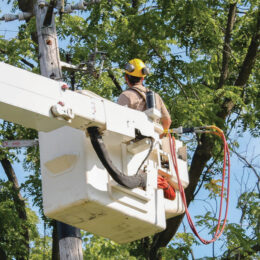
President/CEO
You may not think you need to understand energy demand and purchasing, but do you ever look at your energy bill and wonder what it all means? If your answer to that question is “yes,” then you might be interested to learn how demand impacts your utility bill.
Before Noble REMC can send electricity to your home, that electricity needs to be generated by a generation and transmission cooperative. For Noble REMC, that cooperative is Wabash Valley Power Alliance (WVPA) — a name you may have seen in this publication previously.
Once the electricity has been generated, it travels over high-voltage transmission lines — you often see the large steel structures making their way across farms — to substations, where the voltage is reduced to an optimum level. The electricity then travels over our distribution power lines until it reaches the transformer on a pole or in a green cabinet (called a pad-mount transformer) on your property, where the voltage is again lowered and transported into your home. So, while you pay your bill to us — your electric distribution cooperative — we don’t actually generate the electricity you use. That is the job of WVPA.
We do help determine how much electricity our members need to power their homes and businesses, and you play a big part in determining how much electricity WVPA needs to supply in order to keep the lights on in our community. That is where these terms “consumption” and “demand” come in.
Consumption is measured in kilowatt-hours (kWh). Demand is measured in kilowatts (kW). A lightbulb “consumes” a certain number of watts, let’s say 100 watts per hour. If that lightbulb stays on for 10 hours, it “demands” a certain number of kilowatts (in this case, 1 kW) from the generation station producing electricity. Now, if you turn on 10, 100-watt lightbulbs in your home for one hour, you are still consuming the same number of kW. However, you are placing a demand on the utility to have those kW available to you over the course of one hour, instead of 10. This requires the generating plant to produce and deliver more power in less time in order to meet your demand.
A big component of Noble REMC’s power cost from WVPA is based on the peak demand of our roughly 11,500 members. Peak demand refers to the time of day when the demand for electricity is highest. This is typically during weekday evenings when families return home from work or school, cook dinner and use appliances the most.
Using electricity during this peak demand period often costs more to both Noble REMC and to our members. Take note (and take time) to schedule your electricity-dependent chores outside of the peak period from 4-8 p.m. on weekdays. We all save when you do.
Demand and consumption are the reason your electricity bill fluctuates season to season and even year to year. Generating and distributing power can be a tricky and complicated business, but rest assured, Noble REMC will always meet the necessary demand to provide safe, reliable and affordable electricity to your family.



